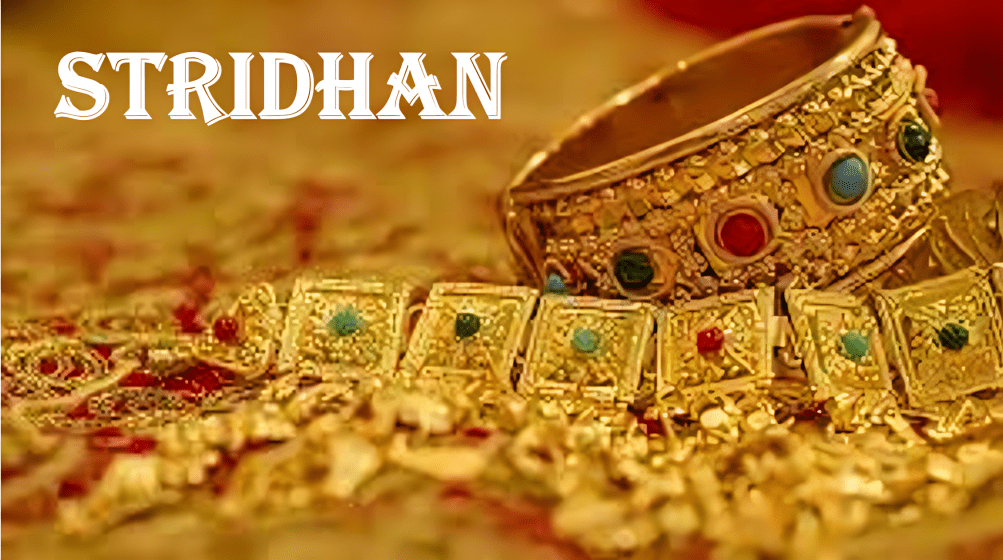
This article is written by Hrishika Sahu of Symbiosis Law School, Hyderabad, an intern under Legal Vidhiya
ABSTRACT
This article examines the historical background of women’s property rights in ancient patriarchal India while focusing on the transformation brought about by the Hindu Succession Act of 1956. It explores the idea of women’s estate and Stridhan, emphasising the important modifications to women’s property rights brought about by section 14 of the Act. And clarifying the legal complications of the many forms of women’s property – gifts, bequests, inherited property, and more are addressed.
Also, the article acknowledges women’s empowerment under the Hindu Succession Act, allowing complete ownership and control over the property and granting daughters equal coparcenary rights, and the subsequent laws surrounding its applicability.
Keywords
Stridhan, Women’s Estate, Hindu Succession Act of 1956
INTRODUCTION
Over several decades, resistance against equality and empowerment has been felt in ancient patriarchal India. Jill Lepore’s book “The Secret History of Wonder Woman” sheds insight into the discontented lives of women managing marriage, family, and education. In the patriarchal ancient civilisation, women were often repressed and subjugated by males. This was made explicit in the ancient literature Manusmriti. “Her father protects her in childhood, her husband protects her in youth, and her sons protect her in old age; a woman is never fit for independence,” Manu said in the Manusmriti scripture, stressing the precarious position of every woman who is bound by dependency and repression[1].
“Stri” means women, and Dhana, which suggests property, is the root of the term Stridhan. Thus, we derive the Stridhan attribute of women by joining these two terms. Over the ages, this expression originated in Hindu Smritis and evolved to include all types of marriage in recognisable caste. To put it more broadly, Stridhan is a woman’s property that she owns wholly. Significant changes to the Hindu law regarding women’s property were introduced by Section 14 of the Hindu Succession Act, 1956.
Women’s property was divided into two heads before 1956: women’s estate and Stridhan. However, everything has been given a technical interpretation in Hindu law. Under Hindu law, a woman can possess and dispose of property. At no point has the woman’s use of the property as the only owner been denied. Any valuable asset that a woman possesses alone is referred to as a Stridhan[2].
STRIDHAN AND WOMEN’S ESTATE
Before the Hindu Succession Act was enforced, women’s property was categorised as:-
Stridhan
Hindu women’s property rights witnessed significant changes in ancient India; in many instances, their share of the property was significantly lesser than that of their male counterparts. The goods bestowed upon the ladies were commonly referred to as Stridhan, and they are derived from the marital gifts—such as clothing, jewels, and ancestral properties—that a woman received upon her marriage. Except for a small portion of the succession of landed family property, the women’s property rights were revoked with regard to inherited or married landed property. These patriarchal conventions were totally overthrown by the introduction of The Hindu Succession Act of 1956, which gives property ownership total control.
Women’s estate
The scope of women’s estates and property deals with the notion of women’s limited rights and ownership over property, which continued until 1956 when section 14 of The Hindu Succession Act 1956 abolished it and gave women full ownership of rights and property. Any property owned by a female Hindu, whether acquired before or after the beginning of this Act, will be held by her as complete owner and not as a limited owner, as mentioned expressly in section 14 (1) of The Hindu Succession Act, 1956. [2] To put it unam biguously, it emphasises women’s rights to possess, utilise, and dispose of their property whenever desired. The property owned by a Hindu woman under clause 1 of section 14 of the Act is absolute and cannot be defended. The Supreme Court stated in Punithavalli v. Ramalingam[3]that no text, inference, theory, or rule under that statute may restrict the extent of such property.
Nonetheless, the court held that the Hindu woman is deemed the exclusive owner of whatever property she possesses as of the day the act went into effect, regardless of whether it was acquired before or after the act’s enactment in the case of Santhosh and Ors Vs. Saraswathibai and Anr[4] , the Supreme Court decided that the estate would be considered to be owned by the widow and that she would have acquired full or absolute rights over the property under section 14(1) if she received a stake in the property under a preliminary declaration before to or at the time the 1956 act had been passed but had not been granted real ownership under a final statement[5].
Kinds of Woman’s Property
- Bequeaths and gifts from relations- A woman can receive such gifts from her parents and their relatives or from her husband and his relatives when she is in maidenhood, coverture, or widow. These bequests may be made via a will or inter vivos. The Dayabhaga School does not consider a husband’s gift of immovable property as Stridhan. Mitakshara II ix, 2
- Bequeaths and gifts received from outsiders during marriage- A woman’s Stridhan is the property she acquires as a gift inter vivos or under a stranger’s will that is not related to her when she is a maiden or widow. The status of gift given to a woman by strangers before to the marriage ceremony or during the bridal procession is also the same. According to the schools of Bombay, Benaras, and Madras, property gifted to a woman by strangers during her coverture or given to her as a gift inter vivos is Stridhan.
- Property acquired by a partition- In the Mitakshara jurisdiction, which includes Bombay and the Dayabhaga school, it is a widely recognised notion that the portion obtained on partition is not Stridhan but woman’s estate. When a partition takes place, except Madras, the father’s wife, mother, and grandmother take a in the joint family property.
- Property given in place of maintenance – According to all schools of Hindu law, Stridhan is the whole amount of arrears for maintenance payments given to a Hindu woman periodically. In the same way, her Stridhan consists of all assets, whether movable or immovable, that are given to her as an absolute gift instead of maintenance.
- Property that was inherited- A Hindu woman can inherit property from either her husband’s or her parents’ side. She can inherit property from either gender. Although the Privy Council considered such property to be a woman’s estate, the Mitakshara categorised all inherited property as a stridhana.
- Property obtained by skill or exertion- At any moment in her life, a woman can become a property owner by working for herself, whether it is through manual labour, employment, singing, dancing, or any other kind of mechanical art. All schools of Hindu law hold that the property she earned in this way, whether she was a widow or a maiden, is her Stridhan. However, according to Mithila and Bengal Schools, the property she obtained during coverture does not count as her Stridhan; however, the remaining schools believe it does. The husband has power over it when he is alive.
- Property obtained by adverse possession- A woman’s Stridhan is any property that she has obtained through adverse possession at any time in her life.
- Property bought with income-savings- It is a well-established law in all schools of Hindu law that all properties acquired with Stridhan or with Stridhan savings, along with all accumulations and savings of Stridhan earnings, comprise Stridhan.[6]
WOMEN’S RIGHTS OVER HER STRIDHAN OR ESTATE
The bride has full authority over all of the assets she has acquired throughout her marriage, encompassing both moveable and immovable property. Throughout her life and beyond, she also has the authority to dispose of, alienate, or give away at her own discretion. The Stridhan are not within her husband’s authority or any other family members, including the Karta. In the Ashok Laxman Kale vs. Ujwala Ashok Kale[7] case, the court held that A girl who is particularly educated these days should be able to take care of her own Stridhan in terms of safety and security, such as opening a bank locker in her name for purposes such as storing jewellery and money instruments, property, etc., or keeping it under lock and key.
The following are a few preventative steps to monitor the Stridhan:
- Keeping track of every gift and possession that the husband or wife’s family, friends, and other relatives have given before, during, and after marriage.
- Keeping proof of all the gifts and assets such as digital evidence in the form of marriage pictures, bills and envelopes of the gift, etc.
- Keeping the salary in a other bank account that is in her name.
- Keeping track of the investments and bank accounts after investing a Stridhan.
- Making certain that the title and status of any properties received or gifted from her Stridhan are clear and on her behalf.
- The money invested using the stridhan’s assets has to be her name.
POWERS OF WOMAN OVER HER STRIDHAN
Authority and power to manage the stridhan’s or woman’s estate are completely vested in the woman under the power of management. She is regarded as superior to all other members, even the Karta of the Joint Hindu Family, because she is the only owner. She is completely entitled to her estate’s use, upkeep, and revenue and the flexibility to invest or spend her profits (Stridhan) in whatever she pleases. She has the authority to file lawsuits on her estate’s behalf and be sued herself. The concerned woman is the only owner until she passes away, remarries, is adopted, or surrenders her inheritance.
Power of Alienation: The following situations fall under the woman’s capacity to alienate her estate or property under the power of alienation:
- Legal requirement about her own needs or the needs of the former owner’s dependents.
- In the estate’s best interests.
- She has the option to alienate for the advantage of the former owner rather than her own personal gain in order to remove the essential religious requirements, such as the marriage of daughters and the husband’s death rites.
In the Ramappa v. Chandangouda[8] case, one of Hanamgouda’s widows sold her husband’s land to the first defendant. In 1948, she was married again. Then, the plaintiff’s reversioner brought a demand for ownership restoration. The first appeal court ordered it, notwithstanding the court of justice’s rejection, citing a legal requirement.
Power to relinquish: Whenever a female owner exerts her power to relinquish, she is giving up ownership of the estate. A woman may do it voluntarily while she is still alive or as soon as she passes away. The woman has a choice to give her inheritance to her nearest heir, which will completely obliterate all the rights over the property. The Supreme Court drew the law in this context in the case of Natvarlal Punjabhai and Another v. Dadubhai Manubhai and Others.[9]
WOMEN’S RIGHT TO PROPERTY – THE HINDU SUCCESSION (AMENDMENT) ACT, 2005
The Hindu Succession (Amendment) Act, 2005 established as legal for women to be coparceners. This entails that the daughters had the same rights and obligations over the joint Hindu family property as sons, and that they were coparceners from birth. If their father passes away and there is debt that has to be paid, then both of them will be equally responsible for making those payments. The survivorship law, which prevented women from coparcening on ancestral property, was repealed and daughters were now allowed to do so. The act came into effect on September 9, 2005. after that, there were multiple arguments about whether or not women could inherit property if their father passed away before 9 September 2005. There was also judicial tension because, in some cases, the courts permitted women to claim their rights, while in other cases, they denied them. Ultimately, this tension was resolved in a very recent case.
The division bench, which included Justice Anil Dave and A.k. Goel, held in the Prakash v. Phulwati’s[10] case was that women could not obtain coparcenary rights over the ancestral property if their father had passed away before the date of enforcement. They stipulated that the father has to be living on that date.
In contrast, the court took a completely opposite stance in the Danamma v. Amar[11] case, ruling that the daughter would continue to be granted coparcenary rights even if the father dies before the act enforcement date.
After a lot of argument about the applicability, the conflict came to an end when the Constitutional Bench, which included Justices Arun Mishra, Abdul Nazeer, and M.R. Shah, in the case of Vineeta Sharma v. Rakesh Sharma stated that women were entitled to inherit ancestral property from birth, regardless of whether her fathers was still alive. As a result, this case resolved all of the ambiguities[12].
CONCLUSION
With a focus on the Hindu Succession Act of 1956, there was a transformation in women’s property rights, particularly the abolition of women’s estate and the recognition of Stridhan as exclusive property.
Several kinds of women’s property and highlights the rights that section 14 of the Act gives Hindu women. Women have authority over their Stridhan and offer advice regarding protecting these rights in the future. Additionally, the crucial contributions made by the Hindu Succession (Amendment) Act of 2005 gave daughters equal coparcenary rights and eased legal disputes over inheritance.
The Hindu Succession Act’s enactment is a positive step in safeguarding Hindu women’s property rights. Thanks to this Act, women now have access to some advantages they had been denied for many years. Furthermore, since it has eliminated a woman’s restriction on acquiring and possessing land as its sole owner, it represents a significant achievement for women’s rights. The Hindu Succession Act’s 1956 Section 14 has undoubtedly served as a safety net for women, particularly Hindu women. Women are now granted such rights, which they had been denied for generations.
REFERENCES
- https://lexpeeps.in/stridhan-and-womens-estate-under-hindu-law/, visited 20-01-2023
- https://www.legalserviceindia.com/legal/article-4302-characteristics-and-features-of-stridhan-and-woman-s-estate.html, visited, 20-01 2024
- https://www.scribd.com/document/495843457/FAM-PROJ,visited on 21-01-2024
- https://www.498a.org/contents/general/streedhan.pdf, ,visited on 22-01-2024),
- https://ijirl.com/wp-content/uploads/2022/02/STREEDHAN-AND-WOMENS-RIGHT-TO-PROPERTY.pdf, visited, 20-01 2024
[1] Ritesha das, Stridhan and Women’s Estate Under Hindu Law, LEXPEEPS (Jan. 20,2023), https://lexpeeps.in/stridhan-and-womens-estate-under-hindu-law/
[2] Raj Kapadia, Characteristics and features of Stridhan and Women’s estate, LEGAL SERVICE INDIA, (Jan 20, 2024),https://www.legalserviceindia.com/legal/article-4302-characteristics-and-features-of-stridhan-and-woman-s-estate.html
[3] Punithavalli v. Ramalingam, 1970 AIR, 1730 1970 SCR (3) 894 1970 (1) 570
[4] Santhosh and Ors Vs. Saraswathibai and Anr, AIR 2008 SC 500
[5]Sai Malvika Tulugu, Stridhan and Woman’s Estate, SCRIBD, (Jan. 21. 2024), https://www.scribd.com/document/495843457/FAM-PROJ
[6] Vibha sirothiya, Stridhan and woman’s estate under section 14 of Hindu Succession Act 1956, 498A.ORG,( Jan 22, 2024), https://www.498a.org/contents/general/streedhan.pdf
[7] Ashok Laxman Kale vs. Ujwala Ashok Kale, 2007 (1) Bom.C.R.16
[8] Ramappa v. Chandangouda, 1960 Mys 260
[9] Natvarlal Punjabhai and Another v. Dadubhai Manubhai and Others, 1954 AIR 61, 1954 SCR 339
[10]Prakash v. Phulwati’s, (2016) 2 SCC 36
[11]Danamma v. Amar, AIR 2018 SC 721,2018
[12] Snehal Upadhyay, Streedhan and women’s right to property, INDIAN JOURNAL OF INTEGRATED RESEARCH IN LAW, (Jan. 23, 2024), https://ijirl.com/wp-content/uploads/2022/02/STREEDHAN-AND-WOMENS-RIGHT-TO-PROPERTY.pdf
Disclaimer: The materials provided herein are intended solely for informational purposes. Accessing or using the site or the materials does not establish an attorney-client relationship. The information presented on this site is not to be construed as legal or professional advice, and it should not be relied upon for such purposes or used as a substitute for advice from a licensed attorney in your state. Additionally, the viewpoint presented by the author is of a personal nature.




0 Comments